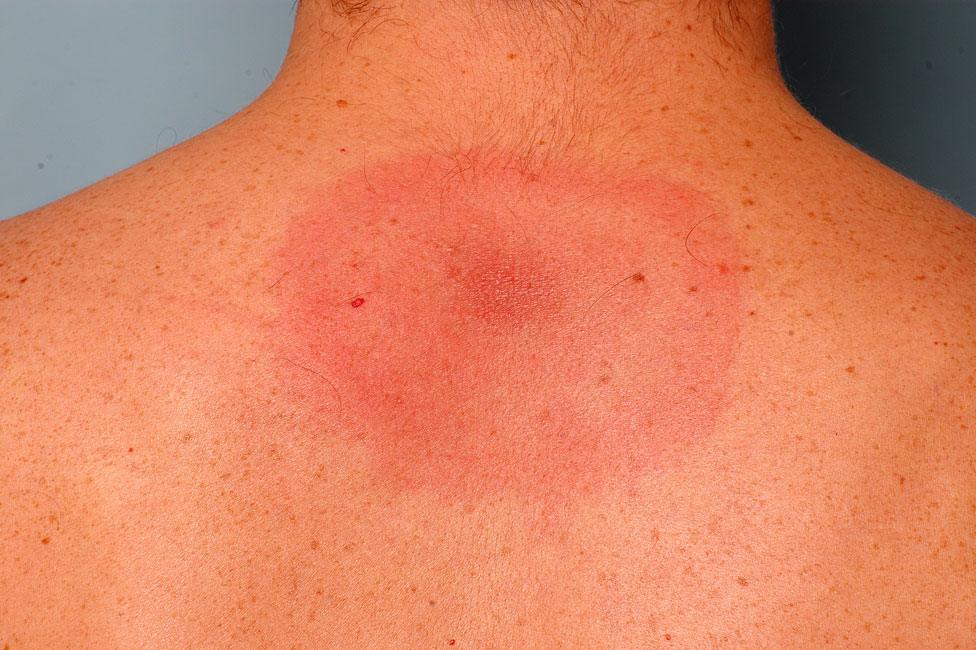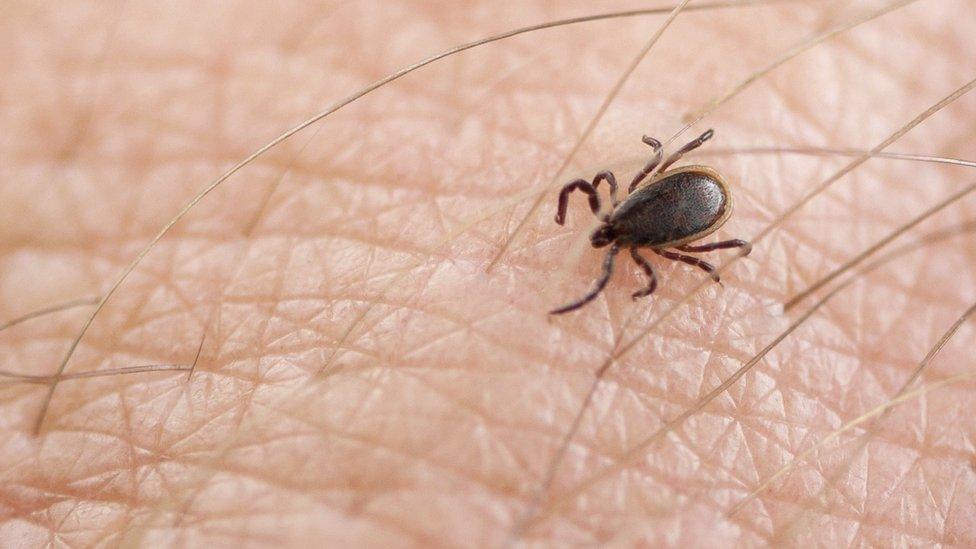How I was floored by a tick
- Published

When Allan Little began to feel ill, he knew almost immediately what it was - Lyme Disease. But getting a medical diagnosis, and treatment, took a lot longer.
I'd been going for years to the same little town in New England and Lyme Disease is everywhere there. You can't walk more than a few hundred metres in the countryside without coming across a public health notice warning you not to get bitten by a deer tick.
So the intense headache, the aching limbs, the burning joints, the ferocious fever and night sweats that hit me in a matter of hours, a few days after I'd got back to London, were all consistent with what I'd read about the condition.
I went to a London GP, who wasn't convinced. She took a blood sample and advised me to go home, rest, and take paracetamol.
The next day, the blood test came back. It was negative for Lyme.
My condition grew worse. I could hardly stand up. I called another doctor, who came to my house. He was also sceptical. He took another blood test. This too came back negative. But he gave me a prescription for powerful painkillers which made me feel well enough to get on a train to Edinburgh, my home town.
Within three hours of arriving at Waverley Station I was an in-patient in the Infectious Diseases Department of the city's Western General Hospital: diagnosis, Acute Lyme Disease. By now I had found the tick bite and the distinctive livid red rash, about six inches in diameter. (To be fair to those London GPs, I hadn't noticed it when I'd consulted them.)

A stock photo of a rash often caused by Lyme disease, with concentric rings
"It's attacked your liver," the Edinburgh Consultant said. "You have three distinct kinds of liver inflammation". I made a lame sick-bed joke: "You're sure that's not like Lager-and-Lime Disease then?" She laughed politely and reassured me that that would look quite different.
Why then had both blood tests come back negative? Dr Roger Evans of Raigmore Hospital in Inverness is one of the UK's leading Lyme Disease researchers. "In early Lyme Disease," he told me, "the test is not reliable because no antibodies have been produced. In the first few weeks of infection, you could test negative, but still have Lyme Disease."
This is a problem for GPs, especially in urban centres where Lyme Disease is unfamiliar. Lyme is not a viral infection. It's bacterial. GPs will not prescribe antibiotics if they think you're showing symptoms of a viral infection - and it does look and feel like a bad case of flu, or chronic fatigue syndrome, neither of which can, or should, be treated with antibiotics.
"In the early weeks of infection, when the blood test is not reliable," says Evans, "the GP needs to assess the patient clinically, looking for other symptoms that identify Lyme Disease." In other words, symptoms that distinguish it from flu.


If you have been bitten:
Remove the tick as soon as possible - the safest way is to use a pair of fine-tipped tweezers, or a tick removal tool
Grasp the tick as close to the skin as possible, pull upwards slowly and firmly, as mouthparts left in the skin can cause a local infection
Once removed, apply antiseptic to the bite area, or wash with soap and water and keep an eye on it for several weeks for any changes
Contact your GP if you begin to feel unwell and remember to tell them you were bitten by a tick or have recently spent time outdoors

Catching it early is vital. Angela Howard fell ill with Lyme Disease in the 1990s. She had never heard of it. Her doctor, she says, told her to go home and see whether her symptoms persisted. It was only when a visiting American friend saw the distinctive rash - concentric red rings around the place where the tick bite had occurred that she realised she might have Lyme Disease. She says her doctor was still reluctant to diagnose Lyme.
"Doctors say you can only get this abroad - that it comes from overseas. But I hadn't been abroad. I'd been picnicking in Wiltshire."
She was not treated early and her symptoms have persisted for years.

A warning sign in countryside near Nantucket, an island off Cape Cod in Massachusetts
There is an accumulation of anecdotal evidence that Lyme Disease often goes undiagnosed. One problem is that no-one knows how prevalent it now is. It is not a notifiable disease in the National Health Service - doctors are not required to inform a central database when they diagnose it. So there is no reliable evidence of how widespread it is, or where in the country you are most likely to get it.
Roger Evans at Raigmore Hospital wants to remedy that.
"We're using Scotland as a pilot study," he said. "We're trying to create maps of areas where there's a risk of tick exposure. We're using satellite data from the European Space Agency to create an app that will give information, but which will also be interactive, so that users can put in information about where they've been bitten and whether the Lyme Disease rash has appeared."
Why has Lyme, which 30 years ago seemed largely limited to a small area of New England - Lyme is the town in Connecticut where it was first identified - now so prevalent across the continental USA and in Europe? One theory is climate change: that small gradations in climate can create new habitats for micro-organisms, or keep them alive and active for longer.

A mother and children going walking near Lyme, Connecticut
I was struck, at the time of my own treatment, that awareness was far greater in Scotland than in England and Wales. And awareness of the condition is vital to catching it early. For when you catch it early, treatment is easy and in most cases successful.
It floors you though. It took me four or five months to get my strength and stamina back.
It is a debilitating and dangerous illness and there is no doubt that it is getting more common. You can get it in the Scottish Highlands, in Devon and Cornwall, in Richmond Park in London and probably in your own back garden - anywhere where there are small furry animals on whose skins a deer tick can live.
If you get it, you can get treatment. But take it from me: it really helps if you know what it is you've got.

Find out more
Listen to Allan Little talking about his experience with Lyme Disease on Broadcasting House at 09:00 on Sunday 31 July, on Radio 4, or catch up later on the BBC iPlayer.
Further reading:
The controversy over the chronic form of Lyme Disease

Follow @BBCNewsMagazine, external on Twitter and on Facebook, external